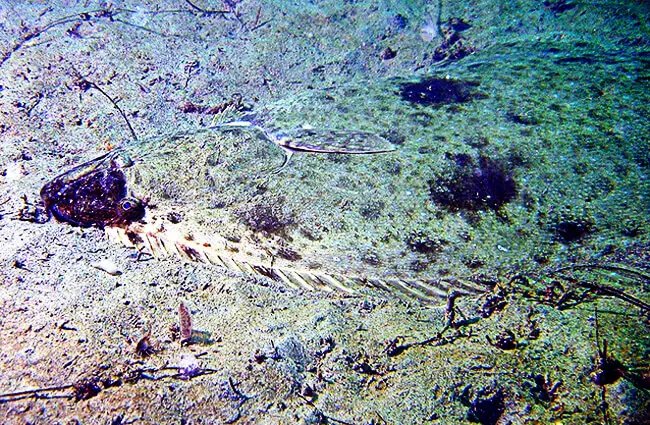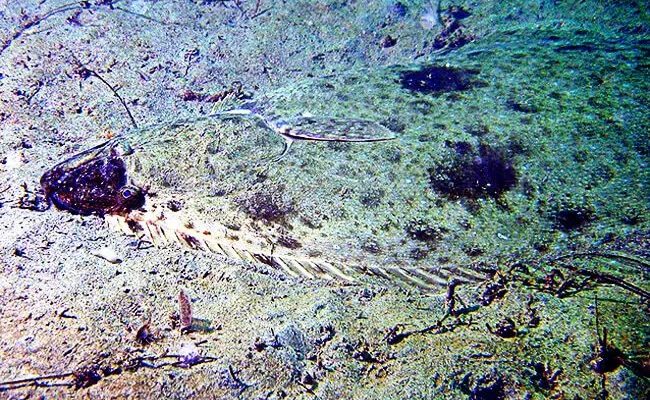
If you’ve ever seen a halibut, you might notice how different it looks compared to other fish. With its flattened body and camouflaged skin, it’s like a master of disguise. Let’s dive into the underwater world of halibuts and explore how they’ve evolved to not only exist but flourish beneath the waves.
Shape and Size: Nature’s Clever Design
The shape of a halibut contributes massively to its success in the wild. Their flat, oval bodies allow them to lie nearly motionless on the seafloor, making it easier to avoid predators. Imagine being able to blend in with the sandy bottom like a chameleon at a party—this is exactly what halibuts do!
Their size also plays a crucial role. Halibuts can grow over 500 pounds and reach lengths of up to 8 feet. This grand size means they can be dominant predators. Larger halibuts have fewer natural enemies, which ensures they have plenty of opportunities to hunt for food. Think of them as the gentle giants of the ocean floor.
You might be wondering how they manage the energy demands of such a large body. Here’s the thing: halibuts are generally slow swimmers. This slower pace allows them to conserve energy, which is vital for these big fish that primarily feed on smaller fish like herring and cod.
Camouflage: Blending In with the Seafloor
One of the coolest adaptations of the halibut is its ability to blend into the seafloor. Their skin is covered in a unique layer of pigments that can change color, helping them camouflage themselves against sandy or rocky bottoms. This skill isn’t just for hiding from predators; it also allows them to ambush prey.
When they’re resting on the ocean floor, halibuts look like a patch of sand or mud, making it difficult for curious fish to spot them. It’s almost like they have their own built-in invisibility cloak! This method of concealment is a perfect example of how nature equips creatures with tools to survive.
In addition to color changes, halibuts have tiny, bumpy scales called tubercles. These not only help with texture but also assist in reflecting light. So when light hits them just right, they can become even more challenging to notice. Imagine trying to find a needle in a haystack—that’s how well they blend in!
Feeding Habits: Master Predators of the Ocean Floor
Halibuts are primarily ambush predators. They spend a lot of time lying in wait for an unsuspecting fish to swim by. When it comes to feeding, they have an impressive jaw structure. Their large mouths can open wide to gulp down prey, which often includes smaller fish and crustaceans.
Here’s the thing: halibuts don’t just rely on speed or agility to catch food; they use a strategy. They’ll bury themselves in the sand, only showing their eyes and mouth, allowing them to surprise their prey. It’s like playing hide and seek but with a much higher stakes dinner menu!
Their diet varies depending on their age and size. Younger halibuts may eat smaller invertebrates, while adults often feast on larger fish. This ability to adapt their diet to the available food sources helps them thrive in various environments, from shallow coastal areas to deep-sea habitats.
Eyes on One Side: Nature’s Special Touch
One of the most distinctive features of halibuts is their unique eye placement. As they grow, one eye migrates to the other side of their body, giving them a strange but effective look—two eyes on one side! This adaptation is vital for their lifestyle.
With both eyes on the “upper” side, halibuts can easily monitor their surroundings while lying flat on the ocean floor. Imagine being able to see everything happening around you without moving—how cool is that? This positioning allows them to spot predators or potential meals without exposing themselves.
Also, this adaptation aids their camouflage strategy. By having their eyes on top, halibuts can keep a watchful gaze from a position that blends seamlessly into their environment. They truly are the stealthy ninjas of the ocean!
Behavioral Adaptations: A Survival Strategy
Halibuts have some interesting behaviors that help them survive and thrive in the ocean. One such behavior is their migration patterns. These fish will often move to shallower waters during spawning seasons. This migration ensures they find the right conditions for their eggs to develop, demonstrating a clear adaptation to their life cycle needs.
Additionally, they are mostly bottom feeders but can swim to higher waters for feeding. This flexibility in behavior means they can take advantage of different food sources—great for adapting to changing environmental conditions. If one area is depleted of food, they have the ability to explore.
Their social interactions are also notable. While they can be solitary, halibuts will often gather in schools during certain seasons. This group behavior can help protect them from predators. Think of them like a band of friends working together; there’s safety in numbers!
Halibuts are a prime example of how nature fine-tunes species to live in their environments. From their unique body shape and camouflage abilities to their special feeding strategies and eye placements, every aspect of the halibut is designed for underwater success. They remind us of the incredible diversity in the ocean and how life constantly adapts to thrive.
So, the next time you think of fish, don’t forget about the halibut. These fascinating creatures are not just survivors; they’re perfectly crafted for life under the waves. Their story is one of resilience and adaptability, showcasing the wonder of marine life in all its glory.

